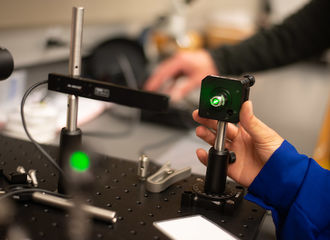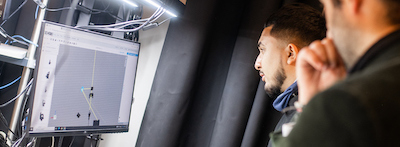Photonics, Optics and Quantum Research
Based on Bridgewater State University's unique faculty, leading-edge equipment and research facility, and strong workforce development, LEAP at BSU has a broad spectrum of photonics-, optics- and quantum-related user inspired research.
BSU has well-established relationships with local companies and industries related to our teaching, research and degree programs. As part of the MassTech LEAP system, BSU collaborates on AIM Photonics and Manufacturing USA initiatives, local workforce education and industrial partnering. LEAP at BSU also partners with LEAPs at other institutions like Worcester Polytechnic Institute and Quinsigamond Community College, Stonehill College, Western New England University and Massachusetts Institute of Technology.
Teachers and K-12
Our photonics and optical engineering degree program is unique in the state of Massachusetts and one of a handful in the country. We host regional meetings, developed a technician training program for photonics and optics, and participate in bootcamps with the other LEAP members. Founded as a school for educators, BSU now offers unequalled access to students in our BS and MAT teaching programs as well as outreach to K-12 classes.
Accordion Content
Lasers
Continuously Tunable (O-E-S-C-L) system for telecommunications bands, Tunable Optical Parametric Oscillator (OPO) in picosecond regime continuous wave (CW) in near and mid IR, Erbium fiber Femtosecond Telecom, External Cavity Diode lasers (ECDL) 780 nm as well integrated III-V quantum dot lasers. Entangled Pair Photon Sources and single photon detection with pair correlation electronics.
Accordion Content
Metrology
Characterization, detection and imaging: 600-1700 nm and 1200-2400 nm OSA, beam profilers and M^2 system, polarization, Near IR camera for telecommunication-band, Waveshaper for spatio-temporal definition of pulses. Beam profilers and wavemeters in the near IR and midIR wavelengths. Spatial light modulators in the visible and mid I.
Accordion Content
Advanced Computing
FEM and FDTD design and simulation packages running off of multiple CPU and GPU blades.
Accordion Content
Multiphysics simulation software is used to simulate photonic and semiconductor structures. Design photonic devices and laser diodes are designed by using ray optics, wave optics, semiconductor, and heat transfer modules. Finite Difference Time Domain(FDTD) and Finite Element Methods (FEM) are available through electromagnetic waves simulation.

